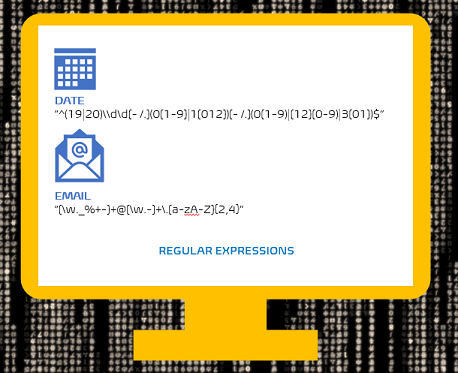When I reviewed a pull request with a few commits focused on regular expression code changes, I decided to re-create a quick reference cheat sheet. Regular expression (regex), a variant of conventional set theory, has a few oddities with infrequent use. Hopefully this cheat sheet will turn regular expressions into a less daunting ally in your world programming and configuration.
Regular Expressions
Common Expressions
| Category | Expression | Description |
|---|---|---|
| Special Characters | . \. \n \f \t \xhhhh |
any character dot newline character form feed character tab character Unicode character as hexadecimal number, i.e. \xFFFF |
| Quantifiers | + ? * {x,y} |
1 or more 0 or one 0 or more at least ‘x’ but no more that ‘y’ occurrences |
| Character Sets | \s \S \d \D \w \W [a-x] [^a-x] |
whitespace character non-whitespace character digit character (0-9) non-digit character any letter (a-zA-Z) or digit (0-9) or underscore (_) character non-word character characters in the range of a to x, excluding yz characters except in the range of a to x, i.e. y and z |
| Anchoring | ^ $ \b \B |
if first char, indicates that match starts at start of string match must continue to end of string word boundary non-word boundary |
Example
Regular Expression Example
| # | EXPRESSION | DESCRIPTION |
|---|---|---|
| 1 | ^ | The first character ^ indicates that the next match (19|20) starts at beginning of string. |
| 2 | (19|20) | We either need a 19 or a 20 at the beginning of the string. |
| 3 | \d\d | Next we have two digit character (0-9). |
| 4 | [- /.] | Next we have a range of valid characters, in this case minus, slash, space and dot. |
| 5.1 | (0[1-9] | Either we have a 0, followed by a digit in the range of 1-9, i.e. 01 to 09. |
| 5.2 | |1[012]) | OR we have a 1, followed by a zero, one or two, i.e. 10, 11 or 12. |
| 6.1 | (0[1-9] | Either we have a 0, followed by a digit in the range of 1-9, i.e. 01 to 09. |
| 6.2 | |[12][0-9) | OR we have a 1 or a 2, followed by a digit in the range of 0-9, i.e. 10 to 29. |
| 6.3 | |3[01]) | OR** we have a three, followed by a zero or a one, i.e. 30 - 31. |
| 7 | $ | The last character $ indicates that the next match must continue to end of string. |
If you need more examples, go to regularexpressions.info.


